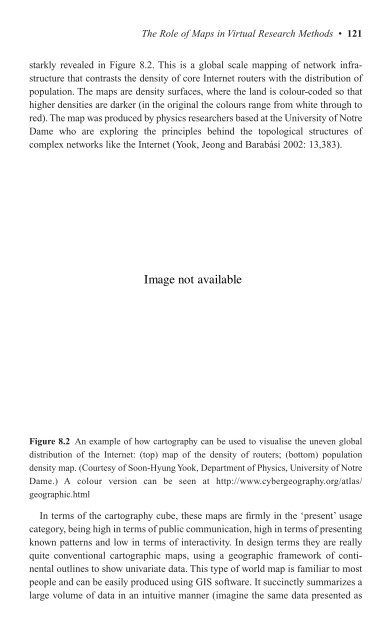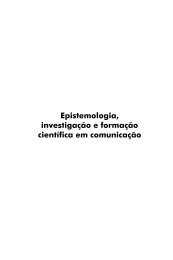- Page 2 and 3:
Virtual Methods
- Page 4 and 5:
Virtual Methods Issues in Social Re
- Page 6 and 7:
Contents List of Figures vii Notes
- Page 8 and 9:
Figures 1.1 References in http://we
- Page 10 and 11:
Notes on Contributors Anne Beaulieu
- Page 12 and 13:
Notes on Contributors • xi Adam N
- Page 14 and 15:
Notes on Contributors • xiii Data
- Page 16 and 17:
-1- Virtual Methods and the Sociolo
- Page 18 and 19:
Virtual Methods • 3 obscuring the
- Page 20 and 21:
Virtual Methods • 5 bid for appli
- Page 22 and 23:
Virtual Methods • 7 our disciplin
- Page 24 and 25:
Virtual Methods • 9 to rest on me
- Page 26 and 27:
Given the emphasis on reflexivity t
- Page 28 and 29:
Virtual Methods • 13 Open Theme,
- Page 30 and 31:
Part I Research Relationships and O
- Page 32 and 33:
Research Relationships and Online R
- Page 34 and 35:
Research and Online Relationships
- Page 36 and 37:
-2- Internet Behaviour and the Desi
- Page 38 and 39:
Internet Behaviour and Virtual Meth
- Page 40 and 41:
Internet Behaviour and Virtual Meth
- Page 42 and 43:
Internet Behaviour and Virtual Meth
- Page 44 and 45:
Internet Behaviour and Virtual Meth
- Page 46 and 47:
Your annual salary Internet Behavio
- Page 48 and 49:
do not sit easily with a researcher
- Page 50 and 51:
-3- Online Interviewing and the Res
- Page 52 and 53:
Online Interviewing • 37 informat
- Page 54 and 55:
The informed consent form was gener
- Page 56 and 57:
days at work, a baby ill the previo
- Page 58 and 59:
communication between the interests
- Page 60 and 61:
Online Interviewing • 45 your ans
- Page 62 and 63:
Online Interviewing • 47 Caroline
- Page 64 and 65:
the maintenance of rapport over tim
- Page 66 and 67:
-4- From Online to Offline and Back
- Page 68 and 69:
From Online to Offline and Back •
- Page 70 and 71:
From Online to Offline and Back •
- Page 72 and 73:
closer, I continued writing with a
- Page 74 and 75:
From Online to Offline and Back •
- Page 76 and 77:
From Online to Offline and Back •
- Page 78 and 79:
From Online to Offline and Back •
- Page 80 and 81:
From Online to Offline and Back •
- Page 82 and 83:
-5- Researching the Online Sex Work
- Page 84 and 85:
Researching the Online Sex Work Com
- Page 86 and 87: place of the Internet in my ethnogr
- Page 88 and 89: Researching the Online Sex Work Com
- Page 90 and 91: high quality and accurate data. Bef
- Page 92 and 93: associated with the intimacies of e
- Page 94 and 95: Researching the Online Sex Work Com
- Page 96 and 97: -6- Ethnographic Presence in a Nebu
- Page 98 and 99: Ethnographic Presence in a Nebulous
- Page 100 and 101: newsgroup stood in a different temp
- Page 102 and 103: Ethnographic Presence in a Nebulous
- Page 104 and 105: Ethnographic Presence in a Nebulous
- Page 106 and 107: Conclusion Ethnographic Presence in
- Page 108 and 109: -7- Centring the Links: Understandi
- Page 110 and 111: Centring the Links • 95 The curre
- Page 112 and 113: Centring the Links • 97 specializ
- Page 114 and 115: Centring the Links • 99 together
- Page 116 and 117: Centring the Links • 101 the numb
- Page 118 and 119: that users converse with the robot
- Page 120 and 121: articles) and teaching resources (f
- Page 122 and 123: Part II Research Sites and Strategi
- Page 124 and 125: Research Sites and Strategies: Intr
- Page 126 and 127: esponse to offline events, such as
- Page 128 and 129: -8- The Role of Maps in Virtual Res
- Page 130 and 131: The Role of Maps in Virtual Researc
- Page 132 and 133: The Role of Maps in Virtual Researc
- Page 134 and 135: The Role of Maps in Virtual Researc
- Page 138 and 139: The Role of Maps in Virtual Researc
- Page 140 and 141: The Role of Maps in Virtual Researc
- Page 142 and 143: The Role of Maps in Virtual Researc
- Page 144 and 145: -9- New Connections, Familiar Setti
- Page 146 and 147: New Connections, Familiar Settings
- Page 148 and 149: New Connections, Familiar Settings
- Page 150 and 151: New Connections, Familiar Settings
- Page 152 and 153: New Connections, Familiar Settings
- Page 154 and 155: New Connections, Familiar Settings
- Page 156 and 157: -10- Doing Anthropology in Cyberspa
- Page 158 and 159: Figure 10.1 The Palace Platform. Fi
- Page 160 and 161: Doing Anthropology in Cyberspace
- Page 162 and 163: Doing Anthropology in Cyberspace
- Page 164 and 165: different places (servers) and diff
- Page 166 and 167: Doing Anthropology in Cyberspace
- Page 168 and 169: Doing Anthropology in Cyberspace
- Page 170 and 171: Notes Doing Anthropology in Cybersp
- Page 172 and 173: -11- Web Sphere Analysis: An Approa
- Page 174 and 175: Web Sphere Analysis • 159 sphere
- Page 176 and 177: Web Sphere Analysis • 161 natural
- Page 178 and 179: Web Sphere Analysis • 163 choose
- Page 180 and 181: Web Sphere Analysis • 165 The sec
- Page 182 and 183: Web Sphere Analysis • 167 it need
- Page 184 and 185: Conclusion Web Sphere Analysis •
- Page 186 and 187:
-12- The Network Approach to Web Hy
- Page 188 and 189:
Network Approach to Web Hyperlink R
- Page 190 and 191:
Network Approach to Web Hyperlink R
- Page 192 and 193:
Network Approach to Web Hyperlink R
- Page 194 and 195:
Network Approach to Web Hyperlink R
- Page 196 and 197:
Conclusion The marriage of arguably
- Page 198 and 199:
-13- Sociable Hyperlinks: an Ethnog
- Page 200 and 201:
the hypotheses guiding this work, w
- Page 202 and 203:
Sociable Hyperlinks • 187 interes
- Page 204 and 205:
Timescapes of Hyperlinks The creati
- Page 206 and 207:
Sociable Hyperlinks • 191 linking
- Page 208 and 209:
Sociable Hyperlinks • 193 symboli
- Page 210 and 211:
Conclusion If connectivity is to be
- Page 212 and 213:
Sociable Hyperlinks • 197 structu
- Page 214 and 215:
-14- Epilogue: Methodological Conce
- Page 216 and 217:
Epilogue • 201 the late 1980s. As
- Page 218 and 219:
In a sense, these observations are
- Page 220 and 221:
The third issue, integration of qua
- Page 222 and 223:
other online forms of survey resear
- Page 224 and 225:
References Adamic, L. A. (1999),
- Page 226 and 227:
References • 211 —— (1995b),
- Page 228 and 229:
References • 213 http://users.wmi
- Page 230 and 231:
References • 215 Denzin, N. K. (e
- Page 232 and 233:
References • 217 Networks: The Fo
- Page 234 and 235:
References • 219 Grossberg, L. (1
- Page 236 and 237:
References • 221 Media Use among
- Page 238 and 239:
References • 223 Kaplan, C., Korf
- Page 240 and 241:
References • 225 McClintock, A. (
- Page 242 and 243:
References • 227 Morley, D. (1980
- Page 244 and 245:
References • 229 Paulhus, D. L. (
- Page 246 and 247:
References • 231 The Web after Se
- Page 248 and 249:
References • 233 Networked Organi
- Page 250 and 251:
References • 235 Cambridge, MA: M
- Page 252 and 253:
References • 237 Yook, S-H., Jeon
- Page 254 and 255:
content analysis assessment of self
- Page 256 and 257:
mobile telephone number, 73 MOO, 85



